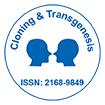
क्लोनिंग एवं ट्रांसजेनेसिस
खुला एक्सेस
आईएसएसएन: 2168-9849

आईएसएसएन: 2168-9849
Raghda Elsawi, Eman Abd El Moemen Mohammed, Noha Mohsen Abogresha, Manal Said Fawzy and Somaya Hosny
Background: Chronic myeloid leukemia (CML) is the commonest neoplasm associated with a recurrent chromosomal aberration (fused bcr-abl gene on the Philadelphia chromosome), The current used methods for generating bcr-abl gene are very expensive and not feasible in labs with limited facilities. So this study aimed at using a simple, safe and non expensive method for generating bcr-abl gene to be used in CML researches.
Methods: Bcr-abl expression was evaluated in two groups; umbilical cord blood CD34+HSCs (UCBCD34+HSCs) nucleofected with the P210pcDNA3 plasmid (n=5) and UCBCD34+HSCs nucleofected with the GFP-encoding plasmid (pMAX-GFP) (n=5). Then, neomycin (G418) antibiotic selection was done. Stable bcr-abl gene expression in G418 resistant P210pcDNA3 UCBCD34+HSCs clones, was evaluated through quantitative PCR analysis of the expression of interleukin one receptor accessory protein (IL1RAP) gene. IL1RAP gene is newly discovered to be expressed on the surface of bcr-abl positive cells.
Results: G418 resistant P210pcDNA3 clones showed up to eleven-fold increase in IL1RAP gene expression compared to pMAX-GFP clones. Our results demonstrated how nucleofection of conventional plasmids is likely to induce gene expression in HSCs.
Conclusion: This simple method of generating bcr-abl gene expressing CD34+ HSCs, shall open new revenues for chronic myeloid leukemia research especially in laboratories, not equipped for advanced and expensive cancer research. Furthermore IL1RAP over expression on the surface of bcr-abl +CD34+HSCs, could be used as indicator for successful stable bcr-abl expression.